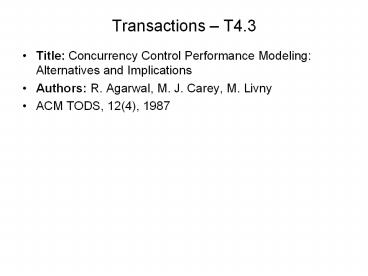Transactions%20 - PowerPoint PPT Presentation
Title:
Transactions%20
Description:
Authors: R. Agarwal, M. J. Carey, M. Livny. ACM TODS, 12(4), 1987. Outline. Problem ... control: methods, performance, and analysis, ACM Computing Surveys, March 1998. ... – PowerPoint PPT presentation
Number of Views:37
Avg rating:3.0/5.0
Title: Transactions%20
1
Transactions T4.3
- Title Concurrency Control Performance Modeling
Alternatives and Implications - Authors R. Agarwal, M. J. Carey, M. Livny
- ACM TODS, 12(4), 1987
2
Outline
- Problem
- Problem Statement
- Why is this problem important?
- Why is this problem hard?
- Approaches
- Approach description, key concepts
- Contributions (novelty, improved)
- Assumptions
3
Problem Statement
- Given
- Alternative Concurrency Control Algorithms (CCAs)
- Transaction Processing Systems
- Find
- Relative performance of CCAs, e.g. dominance
zones - Objective
- Compare CCAs on throughput, response time
- Constraints
- Transaction conflicts
- Database systems resources, models of
transaction restarts - Amount of information about transaction reference
strings
4
Why is this problem important?
- Applications
- Transaction Processing online, batch
- Airline reservation system
- Banking ATM
- E-commerce
Why is this problem hard?
- CCA performance depends on many issues
- Workload degree of conflict among transactions
- Resources, e.g. CPUs, I/O architecture
- Seemingly contradictory results in prior work, p.
610 para 2 - Blocking vs. restarts - 2, 15 vs. 6, 50, 51
- Locks vs. optimistic 20 vs. 2, 15
5
Key Concepts - CCAs
Blocking Locks read lock, write lock Block a transaction if lock request is denied Deadlock detection and resolution wait-for graphs Ex. Dynamic two-phase locking
Immediate Restart Locks read lock, write lock Abort and restart a transaction if lock request is denied Restart delay O(expected transaction response time)
Optimistic Validate only after commit point Restart transaction if validation fails, e.g. if a transaction read an object written by another transaction committed during its lifetime
6
Key Concepts Queueing Model
7
Experiment Design - Parameters
8
Contributions Experimental Results
- 1. Infinite Resources
- Optimistic gtgt Blocking
- Blocking thrashes (Fig. 5) as multi-programming
increases - increase in number of times a transaction blocks
- Standard deviation (response time) less for
Blocking (Fig. 7) - Lock waiting time ltlt Restart time
- 2. Resource-Limited Situation (1 CPU, 2 Disks)
- All exhibit thrashing (Fig. 8) as
multi-programming increases - Disk is the bottleneck (Fig. 9)
- Blocking CCA has highest throughput (Fig. 8)
- And lowest mean response time (Fig. 10)
- 3. Multiple (5 50) Resources
- 5 10 resources behavior similar to resource
limited - 25 resources Optimistic has max. throughput
(Fig. 18, 19) - Disk utilization is better for optimistic (80)
than Blocking (35) - 50 resources similar to infinite resources
9
Contributions Experimental Results
- 4. Interactive Workloads read think write
- Large think time gt low resource contention
- Optimistic gtgt Blocking
- Behavior similar to infinite resources
- Summary Conclusions Based on Resources
- Resource Level
- Medium to High resource utilization Blocking
(2PL) is better - Low utilization Restart methods are better
- Control Multi-programming level
- To avoid thrashing
10
Validation
- Methodology
- Simulation using a queueing model of transaction
processing - A large number of parameters
- Characterize dominance zones
- Validation of Simulation Results
- Physical justification of queueing model
- Experimental results
- Comparison with previous work
- Explanation including alternative causes
- Further experiments to identify causes
11
Assumptions
- Queueing model is a accurate model of OLTP
systems - Parameter Choices
- CCAs
- Write locks are acquired only after read locks
(promotion) - Parameters
12
Rewrite today
- Update with current benchmarks, e.g. TPC
- Parameter values e.g. reflect current database
sizes - Throughput ? TPS including response time
constraint - Candidates ? Newer locking protocols, e.g.
granularity - Transactions ? Use DebitCredit, TPC-A, TPC-C,
- Queueing model ? Complete OLTP systems
- Consider Alternatives
- Analytical solutions
- Trace driven workload characterization and
simulation - See page 79 of
- A. Thomasian, Concurrency control methods,
performance, and analysis, ACM Computing Surveys,
March 1998.

